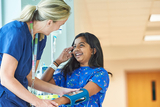Children Everywhere Deserve Breakthroughs. Every day.

CHOP is Where Hope Turns to Healing
Children’s Hospital of Philadelphia has consistently been on the forefront of clinical care with a focus on delivering better outcomes. Our physicians are pioneers and trailblazers with deep multidisciplinary expertise, and our pediatric subspecialties are nationally and internationally recognized, with many top-ranked, year after year.
Our experts constantly evaluate and refine treatment protocols, frequently rewriting standards of care. This desire to think beyond what is currently possible, is what makes CHOP a haven for hope. Here, “impossible” is met with “what if,” innovation meets empathy, and the unbelievable happens.
Here, more children – like Arley – not only survive, but thrive.
From care for rare diseases to routine illnesses, our uniquely comprehensive bench-to-bedside approach is tailored to the individual needs of each child.

50 programs
Specialized to serve our patients, families and community

45 pediatric subspecialties
More than any pediatric hospital in the country

8 specialties ranked top five in the nation
Many are consistently ranked, year after year

33K+ admissions and 1.5M outpatient visits
From all 50 states and 65+ countries, annually
CHOP Transforms Discoveries into Lifechanging Solutions
Children’s Hospital of Philadelphia’s innovative clinical leadership is supported by a dynamic Research Institute, where more than 12,000 principal investigators work tirelessly to push pediatric scientific knowledge forward. As one of the largest pediatric research programs in the country, our elite scientific minds collaborate in a resource-rich environment that enables bench-to-bedside solutions to the most challenging problems facing pediatric health.
From curative therapies for devastating diseases like sickle cell disease, to novel technologies like the world’s smallest pacemaker, to partnerships and public policies that improve children’s safety, our research delivers tangible impact that is changing the trajectory of pediatric health so children and young adults like Marie-Chantel have the opportunity to grow and thrive for years to come.
With unmatched capabilities and a track record to prove it, we are a research powerhouse, actively cultivating avenues of discovery with lifechanging potential.
Largest Biobank
These biological samples of pediatric DNA will unlock new treatments and cures
25 Frontier Programs
Pioneering solutions for complex medical conditions often not available anywhere else in the world; Eight are relentlessly searching for curative therapies
20+ novel diagnostic tests
CHOP-developed tests for rare and complex diseases confirm diagnoses, accelerate treatments and lead to better outcomes

Leading the Way
CHOP has a longstanding history of clinical innovation with countless breakthroughs and dramatic firsts in pediatric medicine. From the first vaccines for life-threatening diseases to the first successful fetal heart surgery to the first cure for genetic blindness, our discoveries have saved countless children’s lives.
CHOP Empowers Communities
At CHOP, we know our responsibility to children’s health extends beyond providing exceptional medical care. From boots-on-the-ground in West Philadelphia to advocating for policy change in Washington D.C., we’re channeling our wealth of expertise to collaboratively tackle the most significant challenges in pediatric healthcare. Together with legislators, educators, community leaders and families, we are removing barriers to care and finding new solutions to catalyze real, substantive change to improve children’s lives.

Caring for Communities
Children’s Hospital of Philadelphia has more than 100 community impact programs tackling a wide range of pediatric health and wellness challenges, from food insecurity to gun violence to child literacy. Our goal is to ensure all children, especially the most vulnerable, have the opportunity to grow and thrive.